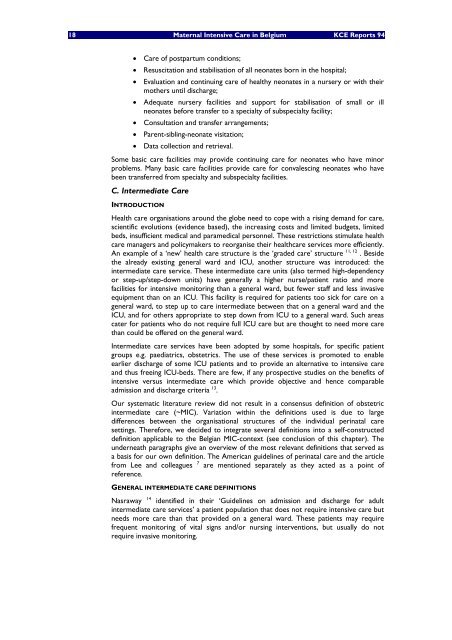Soins maternels intensifs (Maternal Intensive Care) en Belgique - KCE
Soins maternels intensifs (Maternal Intensive Care) en Belgique - KCE
Soins maternels intensifs (Maternal Intensive Care) en Belgique - KCE
Create successful ePaper yourself
Turn your PDF publications into a flip-book with our unique Google optimized e-Paper software.
18 <strong>Maternal</strong> <strong>Int<strong>en</strong>sive</strong> <strong>Care</strong> in Belgium <strong>KCE</strong> Reports 94<br />
• <strong>Care</strong> of postpartum conditions;<br />
• Resuscitation and stabilisation of all neonates born in the hospital;<br />
• Evaluation and continuing care of healthy neonates in a nursery or with their<br />
mothers until discharge;<br />
• Adequate nursery facilities and support for stabilisation of small or ill<br />
neonates before transfer to a specialty of subspecialty facility;<br />
• Consultation and transfer arrangem<strong>en</strong>ts;<br />
• Par<strong>en</strong>t-sibling-neonate visitation;<br />
• Data collection and retrieval.<br />
Some basic care facilities may provide continuing care for neonates who have minor<br />
problems. Many basic care facilities provide care for convalescing neonates who have<br />
be<strong>en</strong> transferred from specialty and subspecialty facilities.<br />
C. Intermediate <strong>Care</strong><br />
INTRODUCTION<br />
Health care organisations around the globe need to cope with a rising demand for care,<br />
sci<strong>en</strong>tific evolutions (evid<strong>en</strong>ce based), the increasing costs and limited budgets, limited<br />
beds, insuffici<strong>en</strong>t medical and paramedical personnel. These restrictions stimulate health<br />
care managers and policymakers to reorganise their healthcare services more effici<strong>en</strong>tly.<br />
An example of a ‘new’ health care structure is the ‘graded care’ structure 11, 12 . Beside<br />
the already existing g<strong>en</strong>eral ward and ICU, another structure was introduced: the<br />
intermediate care service. These intermediate care units (also termed high-dep<strong>en</strong>d<strong>en</strong>cy<br />
or step-up/step-down units) have g<strong>en</strong>erally a higher nurse/pati<strong>en</strong>t ratio and more<br />
facilities for int<strong>en</strong>sive monitoring than a g<strong>en</strong>eral ward, but fewer staff and less invasive<br />
equipm<strong>en</strong>t than on an ICU. This facility is required for pati<strong>en</strong>ts too sick for care on a<br />
g<strong>en</strong>eral ward, to step up to care intermediate betwe<strong>en</strong> that on a g<strong>en</strong>eral ward and the<br />
ICU, and for others appropriate to step down from ICU to a g<strong>en</strong>eral ward. Such areas<br />
cater for pati<strong>en</strong>ts who do not require full ICU care but are thought to need more care<br />
than could be offered on the g<strong>en</strong>eral ward.<br />
Intermediate care services have be<strong>en</strong> adopted by some hospitals, for specific pati<strong>en</strong>t<br />
groups e.g. paediatrics, obstetrics. The use of these services is promoted to <strong>en</strong>able<br />
earlier discharge of some ICU pati<strong>en</strong>ts and to provide an alternative to int<strong>en</strong>sive care<br />
and thus freeing ICU-beds. There are few, if any prospective studies on the b<strong>en</strong>efits of<br />
int<strong>en</strong>sive versus intermediate care which provide objective and h<strong>en</strong>ce comparable<br />
admission and discharge criteria 13 .<br />
Our systematic literature review did not result in a cons<strong>en</strong>sus definition of obstetric<br />
intermediate care (~MIC). Variation within the definitions used is due to large<br />
differ<strong>en</strong>ces betwe<strong>en</strong> the organisational structures of the individual perinatal care<br />
settings. Therefore, we decided to integrate several definitions into a self-constructed<br />
definition applicable to the Belgian MIC-context (see conclusion of this chapter). The<br />
underneath paragraphs give an overview of the most relevant definitions that served as<br />
a basis for our own definition. The American guidelines of perinatal care and the article<br />
from Lee and colleagues 7 are m<strong>en</strong>tioned separately as they acted as a point of<br />
refer<strong>en</strong>ce.<br />
GENERAL INTERMEDIATE CARE DEFINITIONS<br />
Nasraway 14 id<strong>en</strong>tified in their ‘Guidelines on admission and discharge for adult<br />
intermediate care services’ a pati<strong>en</strong>t population that does not require int<strong>en</strong>sive care but<br />
needs more care than that provided on a g<strong>en</strong>eral ward. These pati<strong>en</strong>ts may require<br />
frequ<strong>en</strong>t monitoring of vital signs and/or nursing interv<strong>en</strong>tions, but usually do not<br />
require invasive monitoring.

















